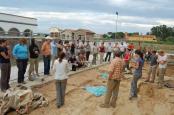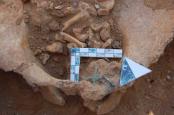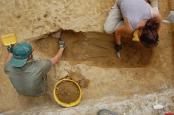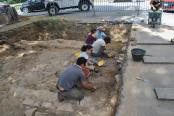CAMPAGNA 2012 |
1° SETTIMANA |
2° SETTIMANA |
3° SETTIMANA |
4° SETTIMANA |
5° SETTIMANA |
6° SETTIMANA |
23 LUGLIO 2012 
Resoconto della giornata di scavo
Area 1000
Dopo aver rimosso lo strato superficiale al’interno del saggio 1500 è stato possibile osservare un livello sottostante (US 1506) caratterizzato dalla presenza del taglio regolare di una sepoltura. Questa è orientata in senso Ovest-Est e nel riempimento US 1503 sono stati rinvenuti numerosi frammenti di laterizi. Nei prossimi giorni seguiremo lo strato US 1506 su tutta la superficie compresa tra le due strutture murarie (US 1008 e US 1018) così da poter analizzare il probabile livello cimiteriale in estensione. Nello stesso tempo prosegue lo scavo nella porzione Nord-Est dell’area in sono stati rimossi i riempimenti di altre due trincee: una (US 1142) di età molto recente, orientata in senso Est-Ovest e l’altra (US 1546) parallela a US 1125 conserva al suo interno frammenti ceramici databili al XVIII secolo.
Today in area 1000, excavation continued on the
series of overlapping trenches in the Northeast quadrant. The fill from the
trenches was removed in preparation for an extensive excavation which will
lower the entire site to a layer of earlier deposition. This excavation will
take place between the two walls exposed last field season running East-West
from the transept of the church. This will also bring the area down to the same
level as the Southwest section 1500.
In section 1500, the bones found yesterday were further excavated to expose an
articulated skeleton. The remains are oriented East to West very close to the
apse and are expected to be removed once excavation resumes tomorrow.
Area 2000
Per quanto riguarda il Settore A, è stata appurata la presenza di un quarto individuo in connessione (Us 2243), nella complessa situazione già parzialmente documentata nel settore centro orientale dell’area. La fossa sepolcrale (US – 2242) risulta intercettata a Nord dal taglio US-2229 (documentato venerdì scorso) e sembra intercettare a Sud la terza sepoltura già individuata la scorsa settimana. L’individuo è orientato Est Ovest e conserva la metà superiore sinistra con l’arto flesso sulle spalle e gli arti inferiori incrociati l’uno sull’altro; la posizione fa pensare alla possibile presenza di un sudario al momento della deposizione del corpo. In giornata è stata completamente rimossa l’Us 2237 con la messa in evidenza di una ulteriore crocetta bronzea dietro la terza vertebra cervicale. In contemporanea, è ripresa l’indagine presso il Settore B. Si è proceduto alla rimozione dello strato US 2219 sotto al quale è emersa una situazione caratterizzata dalla presenza di alcuni tagli (soprattutto verso la porzione più meridionale) di probabile origine sepolcrale. Oltre a questi, è stato individuato un cranio giovanile, ancora da indagare.
Ricostruzione fotogrammetrica della sepoltura Us 2234 |
Since Molly, Guiseppe and Alex had finished removing grave 2234 on Friday, Walker and Adam were able to clean and investigate the bones found within the fill, 2229, and the burials that cut grave 2234. Upon cleaning they found a female burial, 2243, cut saggitally by the earlier grave. They were able to clean and map the skeleton to further understand the burial features in that area of the trench. It is likely that the skull found in fill2229 on Friday belongs to this burial. 2243 was placed in a supine position with arms flexed and lower limbs crossed indicating that she decayed in a shroud.
Molly and Alexa worked in sector B of area 2000 bringing down the top layer (possible US 2218) to reveal earlier structures. Near the south east corner of the trench they discovered an irregular cut used to insert the early 20th century grounding rod. In the central southern section they found a rectangular cut orientated North-South, which may contain a burial. On the south western portion of the trench, there is a long, clean rectangular cut that possible could have something to do with the medieval wall.
Area 3000
Completata la messa in luce dell’individuo US 3187, deposto in decubito supino ed orientato N-S nella porzione S-W del Settore B, si è proceduto con la documentazione e la rimozione dei resti osteologici, in buono stato di conservazione. Sempre nel Settore B è stato terminato lo scavo US 3111, esteso nella zona S-W dell’area, caratterizzato da una matrice limo-argillosa con molti frammenti scistosi e laterizi sbriciolati ed una grande quantità di ossa sparse, ributtate nello strato in seguito alle varie fasi di cantiere connesse con il livellamento dell’area antistante la chiesa. Fra queste ossa ne sono state rinvenute alcune parzialmente in connessione, appartenenti a due individui deposti in decubito dorsale ed orientati N-S. In particolare di US 3181 si conserva il piede, la fibula ed una piccola parte dell’epifisi distale della tibia, così come per lo scheletro US 3182. La rimozione dei resti osteologici ridotti all’interno della cassa litica US 3085 ha inoltre permesso il rinvenimento di una nuova sepoltura in connessione anatomica, ancora in fase di scavo, supina ed orientata W-E, probabilmente in cattivo stato di conservazione.
Today, Frank and Emma finished excavating the headless burial in sector B. They found a piece of glazed pottery, that appears to be some sort of a handle. More bones were found underneath the burial, indicating that there may be a second burial underneath the one that was excavated. Then they continued to expose the medieval wall that divides the sectors. Emilia continued excavation on the scattered human remains located in the Southern portion of the site (in the center). An os coxa and two separate, but articulated lower limbs were removed. Michael continued excavation of the lythic tomb. More skeletal elements were uncovered, removed, and cataloged; including a fifth mandible which brought the MNI to six. This continued after a second photograph and five more levels were taken of the tomb. Tomorrow he hopes to uncover the rest of the articulated skeleton in the tomb. Amanda and Heather were in bone lab.Area 4000
Dopo una prima pulizia generale dell’intera area (nella quale sono state identificate quattro nuove UUSS : 4084, 4085, 4086 e 4087; tutte relative, in diverse proporzioni, a fasi deposizionali successive fra loro), è stato deciso di iniziare, nel settore A, la rimozione di US 4063, lo strato di crollo costituito da lastre frammentate di ardesia e presente sulla quasi interezza dell’area. In questa porzione dell’area, è continuata la pulizia della rasatura della struttura medievale US 4063 e di quella che, a Sud, sembra essere la sua continuazione nonostante la presunta asportazione di suoi elementi (US 4088). La rimozione dell’ingente strato di crollo US 4063 ha restituito diverse situazioni di elevata importanza : uno strato composto da laterizi relativi probabilmente ad un’altra istanza di crollo (US 4089); uno strato di lastre di ardesia ben delimitato e definito al di sopra della rasatura US 4088 ed infine, a ridosso della struttura US 4063, una porzione di colonna dal diametro di circa 30-35 cm della quale è ancora visibile l’anello terminale riconducibile probabilmente ad una delle due estremità della colonna stessa. Le dimensioni e la sua posizione al di sotto dello strato di crollo composto da lastre di copertura, potrebbe portare a verificare l’esistenza di un chiostro interno relativo al monastero oggetto di indagine.
On July 23, in area 4000 we cleaned all of section B and began to excavate section A. We began with the removal of layer 4063 containing the slate tile that we believe is the roof of a medieval building. While doing this, we found a second deconstuction layer (US 4089) of brick and more slate. Within this destruction layer we discovered many pieces of medieval pottery, nails, and animal bones. Next to the wall that seperates our two sections we found a base of a column that is more evidence that our site contains the cloister. Also in the same wall, we found a mysterious cut with fill that runs west to east covered by slate. Tomorrow we will continue to excavate this area.














